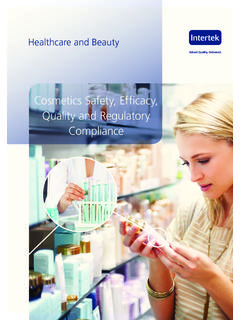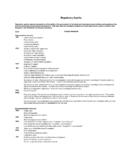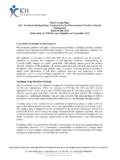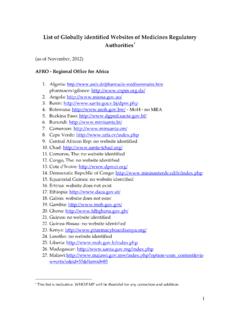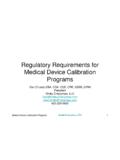Transcription of APEC-OECD INTEGRATED CHECKLIST ON REGULATORY …
1 APEC-OECD INTEGRATED CHECKLIST ON REGULATORY REFORMA POLICY INSTRUMENT FOR REGULATORY quality , COMPETITION POLICY AND MARKET OPENNESS THE APEC-OECD CO-OPERATIVE INITIATIVE ON REGULATORY REFORM is a Joint Activity of the OECD REGULATORY Reform Programme (Directorate for Public Governance and Territorial Development) and the APEC Competition Policy and Deregulation Group (CPDG) convened by the Federal Competition Commission of MEMBER ECONOMIESAPEC has 21 members. The word economies is used to describe APEC members because the APEC co-operative process is predominantly concerned with trade and economic issues, with members engaging with one another as economic entities. AUSTRALIABRUNEI DARUSSALAMCANADA CHILEPEOPLE S REPUBLIC OF CHINAHONG KONG, CHINAINDONESIAJAPANREPUBLIC OF KOREAMALAYSIAMEXICONEW ZEALANDPAPUA NEW GUINEAPERUPHILIPPINESRUSSIASINGAPORECHIN ESE TAIPEITHAILANDUNITED STATESVIET NAMOECD MEMBER COUNTRIESAUSTRALIAAUSTRIABELGIUMCANADACZ ECH REPUBLICDENMARKFINLANDFRANCEGERMANYGREEC EHUNGARYICELANDIRELANDITALYJAPANKOREALUX EMBOURGMEXICONETHERLANDSNEW ZEALANDNORWAYPOLANDPORTUGALSLOVAK REPUBLICSPAINSWEDENSWITZERLANDTURKEYUNIT ED KINGDOMUNITED STATESMEMBER ECONOMIES OF APEC AND THE OECD have recognized that REGULATORY reform is a central element in the promotion of open and competitive markets, and a key driver of economic efficiency and consumer welfare.
2 As a result, agreement for an APEC-OECD Co-operative Initiative on REGULATORY Reform was reached in June 2000 and was endorsed at the APEC Ministerial Meeting on 12-13 November 2000 in Brunei Darussalam, in order to promote the implementation of the APEC and the OECD principles by building domestic capacities for quality regulation. MANY ECONOMIES WITHIN APEC AND THE OECD have individually embarked on ambitious programmes to reduce REGULATORY burdens and improve the quality and cost-effectiveness of regulations. They have collectively endorsed REGULATORY reform principles and policy recom-mendations at the highest political levels, specifi-cally through: The 1999 APEC Economic Leader s Declaration, containing the APEC Principles to Enhance Competition and REGULATORY Reform, The 1997 OECD Policy Recommendations on REGULATORY Reform, and The 1995 OECD Recommendation on Improving the quality of Government preparation of the CHECKLIST represented close co-operation between the APEC Competition Policy and Deregulation Group, and the OECD Horizontal Programme on REGULATORY FIRST PHASE OF THE APEC-OECD INITIATIVE was completed in October 2002, at the High level Conference in Jeju, Korea, where economies agreed on the need to elaborate an APEC-OECD INTEGRATED CHECKLIST for self-assessment on regu-latory, competition and market openness policies, to implement the APEC and OECD principles.
3 The second phase of the initiative focused on the development of the INTEGRATED CHECKLIST which has been presented for approval to the respec-tive Executive Bodies of the APEC and the OECD in 2005. THE CHECKLIST IS A VOLUNTARY TOOL that member economies may use to evaluate their respective REGULATORY reform efforts. There is no single model of REGULATORY reform, but this does not mean that standards, goals and well-structured institutions do not matter. Based on the accu-mulated knowledge of APEC and the OECD, the CHECKLIST highlights key issues that should be considered during the process of development and implementation of REGULATORY policy, while recognizing that the diversity of economic, social, and political environments and values of member economies require flexibility in the methods through which the CHECKLIST shall be applied, and in the uses given to the information compiled. There is little risk that self-assessment will be an exercise in self-satisfaction.
4 Even countries that are well-advanced can find room for OTHER THREE SECTIONS OF THE QUESTIONNAIRES FOCUS ON INDIVIDUAL POLICY AREAS, and the factors that may be considered to improve their specific design and implementation. The policy areas are defined as follows: REGULATORY POLICIES: those designed to maximise the efficiency, transparency and accountability of regulations based on an INTEGRATED rule-making approach and the application of REGULATORY tools and institutions. COMPETITION POLICIES: those that promote economic growth and efficiency by eliminating or minimising the distorting impact of laws, regulations and administrative policies, practices and procedures on competition; and by preventing and deterring private anti-competitive practices through effective enforcement of competition laws. MARKET OPENNESS POLICIES: those that aim to ensure that a country can reap the benefits of globalisation and international competition by eliminating or minimising the distorting effects of border as well as behind-the-border regulations and practices.
5 These policies influence the range of opportunities open to foreign suppliers of goods and services to compete with domestic counterparts in a particular national market ( , through trade and investment). APEC-OECD INTEGRATED CHECKLIST ON REGULATORY REFORMWHILE THE CHECKLIST WILL NOT BE USED FOR COMPARATIVE PURPOSES, it can provide useful information for those economies interested in (i) moving closer to good international practices; and (ii) reducing the uncertainty regarding the implementation of REGULATORY reform principles and institutions, particularly in relation to the dynamic and interrelated effects of competition, market openness and REGULATORY policies. The CHECKLIST creates an orderly framework for decision making that sets out key concepts to guide administrators through the complexities of the design and imple-mentation of an effective and high quality REGULATORY reform policy. This can greatly assist policy makers in identifying options and targeting priorities.
6 THE CHECKLIST IS COMPRISED OF FOUR SECTIONS. The first is a horizontal questionnaire on REGULATORY REFORM across levels of govern-ment that invites reflection on the degree of integra-tion of REGULATORY , competition and market openness policies across levels of government, and on the accountability and transparency mechanisms needed to ensure their success. REGULATORY reform refers to changes that improve REGULATORY quality to enhance the economic performance, cost- effectiveness, or legal quality of regulations and related government formalities. Reform can mean revision of a single regulation, the scrapping and rebuilding of an entire REGULATORY regime and its insti-tutions, or improvement of processes for making regulations and managing reform. Deregulation is a subset of REGULATORY reform and refers to complete or partial elimination of regulation in a sector to improve economic performance. 2IN A CHANGING WORLD, government action remains essential to protect and promote impor-tant social objectives, such as safety, health, and environmental quality , and the international community has taken commitments to several social and environmental agreements in the past decade.
7 Indeed, as economies develop, public expectations in such areas tend to increase. More efficient and dynamic economies will help govern-ments serve these public interests. Experience shows that reform, if properly carried out, should not adversely affect, and can often promote, such objectives. There is scope to consider further how REGULATORY quality affects social and environmental policy CHECKLIST IS THEREFORE AN INTEGRATED SELF-ASSESSMENT TOOL, IN THREE SENSES. First, it integrates the APEC and OECD principles on REGULATORY reform. Second, it integrates the three policy areas competition, rule-making and market openness to provide a coherent whole-of-government view. Third, it integrates governance perspectives transparency, accountability and INTEGRATED CHECKLIST ON REGULATORY REFORMA HORIZONTAL CRITERIA CONCERNING REGULATORY REFORM 4B REGULATORY POLICY 14C COMPETITION POLICY AND LAW 20D MARKET OPENNESS POLICIES 26 MATRIX: THE APEC-OECD INTEGRATED CHECKLIST 12 ANNEX 33 TABLE OF CONTENTS3 HORIZONTAL CRITERIA CONCERNING REGULATORY REFORMR egulatory reform refers to changes that improve REGULATORY quality to enhance the economic performance, cost-effectiveness, or legal quality of regulations and related government formalities.
8 Reform can mean revision of a single regulation, the scrapping and rebuilding of an entire REGULATORY regime and its institutions, or improvement of processes for making regulations and managing reform. Deregulation is a subset of REGULATORY reform and refers to complete or partial elimination of regulation in a sector to improve economic performance. REGULATORY , competition and market openness policies are key drivers for a successful and coherent REGULATORY COMMENTS: The CHECKLIST begins with an assessment of the status of the REGULATORY reform process. The point of departure is to ask whether a REGULATORY reform policy exists. Such a policy often takes the form of a statement setting out principles to govern REGULATORY reform which provides strong guidance and benchmarks for action by officials, and also sets out what the public can expect from government regarding regulation. Thus both domestic and foreign stakeholders would have a statement of government policy for reference, in addition to other obligations that may govern REGULATORY action.
9 The INTEGRATED policy can become a touchstone for government INTEGRATED policy is essential in ensuring that policies for all concerned areas are mutually supportive. It would include key elements, such as transparency, non-discrimination, and minimal interference with competition and open markets, consistent with obtaining these policy objectives. It may set out principles for communication and analysis, including substantive areas to be considered in analysis. An INTEGRATED policy is closely tied to Question A2 since it provides an opportunity for political leaders and senior officials to express their support for REGULATORY To what extent is there an INTEGRATED policy for REGULATORY reform that sets out principles dealing with REGULATORY , competition and market openness policies?COMMENTS: Support and interest in reform activities are key elements for their success. Reforms often confront powerful interest groups outside or inside the government.
10 Often the benefits of reforms are masked by transition costs. But failure to overcome short-term costs and eliminate the economic distortions brought by inefficient regulations nurtures complacency and maintains the status quo, which further increases the costs of reforms. Strong and clear messages and a showing of commitment are needed to build public consensus for reform. How this support is translated in practice is important, all the more so as this affects how businesspeople, consumers and other interested groups react to reforms. This is particularly true with respect to the enhancement of competition and open markets which, while benefiting the economy and consumers at large, may face opposition from particular interests. Political leadership in policy setting helps to balance, when warranted, social and environmental factors with economic, competitive and market-openness objectives in REGULATORY initiatives. While a broad INTEGRATED policy as recommended in A1 is key, high-level commitment also needs to be sustained through time, as often the beneficial impacts of the reforms and enhanced competition and open markets will need months and years to improve the economic structures and processes.










